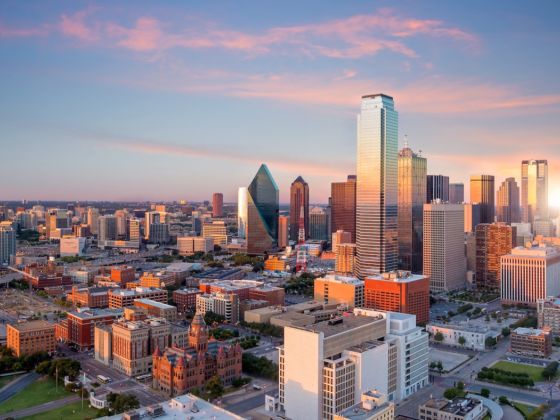

The metro of Dallas-Fort Worth is somewhat of anomaly. Unlike most major American cities, it isn’t located on or near an ocean, major river, or lake, yet it’s still grown year after year to become the fourth-largest metropolitan area in the US. What was once knocked as a “transplant” city has found an edge that is truly its own. Situated in the northeast corner of America’s Southwest, DFW is equal parts Texas, Southeast, Midwest, and big city living — meaning you’ll feel at home wherever you’re from. Another factor adding to the rare beauty of DFW: It’s comprised of two united, yet unique, cities.
In Fort Worth you can enjoy a laid-back vibe that’s historically rooted in cowboys and cattle that large and modern cities often lack. Dallas, on the other hand, is a big, trendy city with plenty of buzzing neighborhoods offering luxury shopping, restaurants, and bars. DFW is a diverse and rapidly changing area. However, one old saying still holds true. Everything really is bigger in Texas, and your visit should be bigger than life too.
Spring and late fall are the best times to visit DFW. The city has moderate temperatures ranging from the high 60s to high 70s from the months of March through May, and things cool off just enough to be light-jacket weather at night. From September to late December, the temperature again levels out in the 80s, 70s, and 60s. It’s also football season, and it’s hard to match the environment in Dallas when the Cowboys are playing.
Like many parts of the South, Dallas is oppressively hot in the summers. We’re talking hot where it feels like the temperature is in the 100s when humidity is factored in. Peak heat is in August. The only escape that makes a summer visit worth it are the many well air-conditioned bars, restaurants, and museums.
For winter, Dallas sees a few rare days of snow a year. The cold is manageable, however, hovering around the mid-50s.
Texas has some of the most lax gun laws in the US and extremely lax gun laws when compared with other parts of the world. That said, tourist-targeted gun violence in both Dallas and Fort Worth is extremely rare. As with any large city, keep your wits about you and avoid walking alone in dark areas.
The main safety concern people should be worried about in Dallas is heat stroke. Stay hydrated out there, people.
You’re going to want (and in some cases need) a car to get around DFW. That applies just as much to in-city trips as it does to trips between Dallas and Fort Worth. The major downside is that Dallas is notorious for its traffic, especially during rush hour, and parking can be tough.
It’s possible to navigate Dallas by public transit, called the DART, it you plan right. The DART is made up of buses and a light-rail system with tickets sold on the bus and at the rail stations. The downtown Dallas Streetcar can get you around that neighborhood while the M-Line Trolley offers free rides from the Arts District to the uptown area. The Trinity Railway Express gets you between Dallas and Fort Worth in an hour.
Dallas also has Uber and Lyft, which come in handy on late nights out.
Everything’s bigger in Texas… including the sports.
By the end, you might develop some theories of your own.